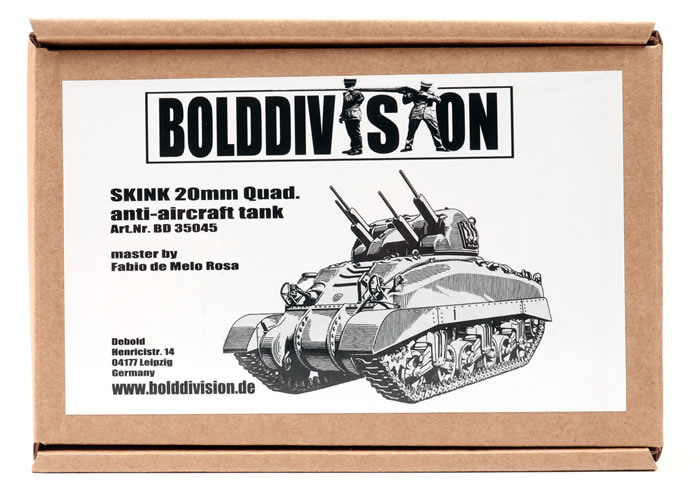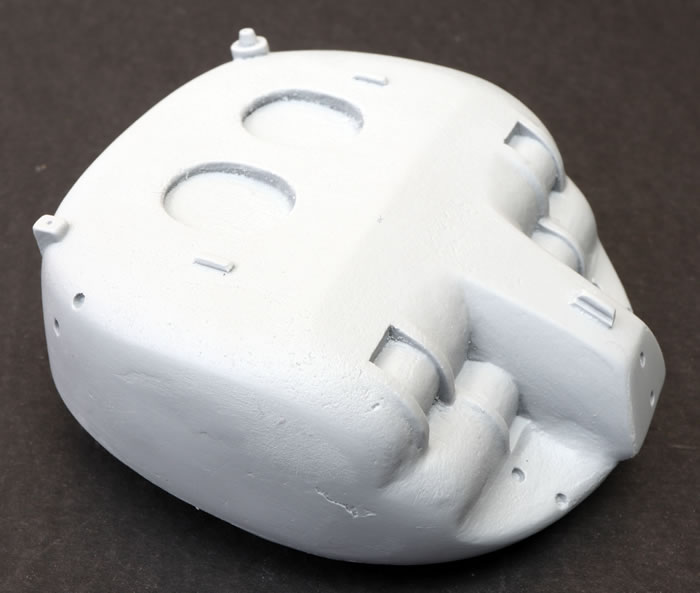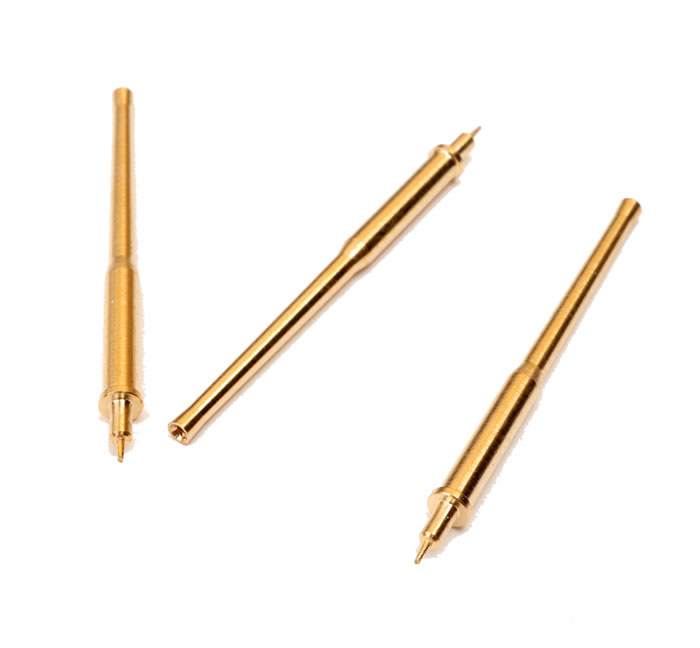|
|
|
|
Skink 20mm Quad Anti-Aircraft Tank
Bold Division, 1/35 scale
Reviewed by Brett Green

| Stock Number and Description | Bold Division Kit No. BD35045 - Skink 20mm Quad Anti-Aircraft Tank |
| Scale: | 1/35 |
| Media and Contents: | 23 parts in grey resin; four turned brass cannon barrels; two lengths of copper wire. |
| Price: | 54,00 € plus shipping available online from Bold Division's web store and other specialist model retailers online and worldwide |
| Review Type: | FirstLook |
| Advantages: | Perfect casting; hgh level of detail; authentic cast surface textures; comprehensive contents. |
| Disadvantages: | No decals. |
| Recommendation: | Bold Division’s 1/35 scale Skink 20mm Quad anti-aircraft tank is a comprehensive conversion for an interesting subject. Detail is good and I am especially impressed with the cast texture. I’m pleased to see the poseable hatches and casting quality is excellent too. With very little cleanup required, this might be a good project for a modeller wanting to take the next step to their first resin conversion. |
Background
Tank AA, 20 mm Quad, Skink was a Canadian self-propelled anti-aircraft gun developed in 1943–44, in response to a requirement from the First Canadian Army.
Due to a lack of threat from the German Luftwaffe, the Skink was cancelled in 1944 after only 3 were built
Development
The development of a fully enclosed quadruple 20 mm mounting on the chassis of the Grizzly tank (Canadian-built M4A1 Sherman tank) was approved by the Canadian Army Technical Development Board as Project 47 in March, 1943. In keeping with the tradition of giving Canadian armoured fighting vehicles animal names, the proposed tank was named after the skink, Ontario's only lizard.
The Canadian Ministry of Munitions and Supply had the turret designed in-house by its Army Engineering Design Branch (AEDB) with help from the Inspection Board. The Waterloo Manufacturing Co. in Waterloo, Ontario, was given the task of building a preliminary wooden mock-up. This was completed on 18 September 1943. The construction of two welded armour pilot turrets was then authorised. The first pilot turret was demonstrated in mid-December. In January 1944 a pilot turret was successfully tested on a Grizzly chassis. Due to the challenges of welding a turret of such a complex shape from Rolled homogeneous armour plate, Dominion Foundries of Hamilton was contracted to produce a fully enclosed cast turret (One of the largest armour castings ever made in Canada).
Originally it was planned to arm the Skink with four 20 mm Hispano-Suiza cannons and the first prototypes were so armed. In January 1944, the 21st Army Group in Europe decided that only British 20 mm Polsten guns would be used (the Polsten was a simplified derivative of the Oerlikon cannon) by its units. This required a redesign of the turret, which was completed in April. This change delayed the project by 3 to 4 months, while 21st Army Group's reduction in the number of AA guns to be issued to its units led to a reduction in the number of Skink turrets which were required. This dwindled to zero in late July 1944, when 21 Army Group decided that as the German air force - the Luftwaffe - had been virtually eliminated over North West Europe, there was no longer a requirement for self-propelled anti-aircraft guns. The Skink contract was cancelled in mid-August and only three complete vehicles and eight turret kits were completed.
Design
The Skink’s four 20 mm guns could fire 650 rounds per minute per gun. A modified Oilgear hydraulic traverse with two pumps could rotate the turret at up to 65° per second and - crucially for a quick response- - accelerate from rest to 60° in two seconds. The guns’ elevation was also hydraulically assisted so the guns could move at up to 45° per second in an arc from -5° to +80°. The gunner controlled both elevation and rotation with a joystick, and used a Mk.IX reflector sight. Initially it was planned to build 300 Skink turrets for the Canadian and British armies. One Skink was sent to Britain for evaluation and was then sent to France for field trials with the First Canadian Army.
Combat Use
From 6 February to 11 March 1945, the Skink visited all but one of the Canadian armoured regiments - from Nijmegen to the Cleve area - frequently engaging the German army. All units found it to be a valuable asset but no enemy aircraft presented itself to the Skink's guns and its main function was to flush out stubborn pockets of enemy infantry and force their surrender. The remaining Skink pilots and the completed turrets went into long-term storage in Canada where, at some point, they were scrapped. Only some unfinished turret castings salvaged from the firing range survive.
FirstLook
Bold Division has released a comprehensive 1/35 scale conversion for the Skink 20mm Quad anti-aircraft tank.
The set comprises 23 parts in grey resin, four turned brass cannon barrels, and two lengths of copper wire.
The conversion should work on any short-hull Sherman kit. I Googled photos of these vehicles and they appeared to be wearing either rubber chevron, steel chevron or Canadian Dry Pin (CDP) tracks. Check your references to see which applies to your chosen vehicle.
Casting quality is excellent and there are no big casting blocks to worry about. Small parts are attached to narrow strips and the larger parts should be ready to use almost straight from the box.
Bold Division has supplied a full upper Grizzly hull. Casting texture is very well done. The turret is hollow cast and the hull hatches are separate parts that may be posed open.

A solid bolted transmission cover is included just in case your donor kit does not come with this option - a thoughtful touch.
The Skink turret is also supplied as a solid casting. Once again, cast texture is convincing.

Although the turret is solid, separate hatches are included so you should be able to fit one or two torso crew figures in the partial openings.
Detail parts include the centre-front mounted gunner’s hatch, the other two turret hatches and the hull hatches, periscopes, armoured engine deck cover, cannon mounts, plus front and rear fenders.

Two pieces of copper wire are supplied - thin and thick - for lifting hooks.
Four gorgeous turned brass barrels are also supplied to finish off the conversion.

Illustrated instructions are supplied on two folded, double-sided A4 sheets. These include diagrams of the markings found on one of the vehicles, although decals are not included.
Conclusion
Bold Division’s 1/35 scale Skink 20mm Quad anti-aircraft tank is a comprehensive conversion for an interesting subject.
Detail is good and I am especially impressed with the cast texture. I’m pleased to see the poseable hatches and casting quality is excellent too.
With very little cleanup required, this might be a good project for a modeller wanting to take the next step to their first resin conversion.
Thanks to Bold Division for the sample www.bolddivision.de
Text and Images by Brett Green
Page Created 31 July, 2021
Page Last Updated
31 July, 2021








